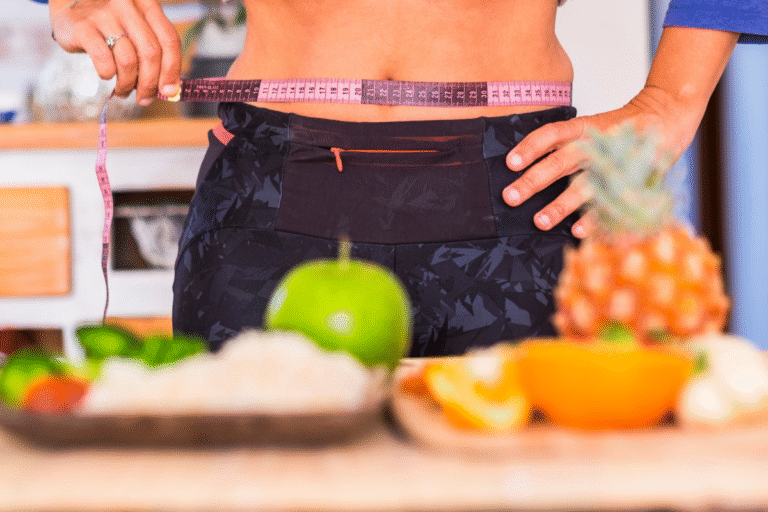
Achieving your health and fitness goals doesn’t have to be complicated. Whether you’re looking to maintain your current weight, lose fat, or gain muscle, starting with accurate data about your body and its needs is essential. This blog will show you how to use ChatGPT to calculate your maintenance calories, macros, and meal plans to optimize results while addressing important concepts like body composition, sustainable calorie deficits, muscle building, and diet breaks.
Finding Your Maintenance Calories
Understanding your maintenance calories (the number of calories your body needs to maintain its current weight) is foundational. We recommend spending time in maintenance to support optimal metabolic, hormonal, and physical health. Maintenance calories fluctuate based on factors like age, sex, body mass, lean muscle mass, activity level, and hormonal shifts (e.g., perimenopause or menopause).
Formulas are used to calculate maintenance calories as just a starting point. Stick with it for a couple of weeks to see where you actually land. If you maintain your weight, this is your true maintenance. If you lose weight, you are eating at a caloric deficit. If you gain weight, you are eating at a caloric surplus. Adjust up or down 200-300 calories until you start getting the desired result, then stick to this until it stops working and you need to adjust again. This is called metabolic adaptation and it is inevitable, but there are steps we can take to minimize it (see Diet Breaks below).
How to Find Maintenance Calories
You can estimate your Total Daily Energy Expenditure (TDEE) using the Mifflin-St Jeor equation:
- Women’s Formula:
- BMR (kcal/day) = 10 × weight (kg) + 6.25 × height (cm) – 5 × age (years) – 161
- Multiply your BMR by an activity factor:
- Sedentary: ×1.2
- Lightly Active: ×1.375
- Moderately Active: ×1.55
- Very Active: ×1.725
- Super Active: ×1.9
Ask ChatGPT:
“Can you calculate my maintenance calories? I’m a 40-year-old woman, weigh 150 pounds, am 5’6” tall, and moderately active.”
Determining Body Fat Percentage
Knowing your body fat percentage helps calculate lean body mass (LBM), which determines your protein requirements. If you only have a scale and tape measure, use the US Navy Body Fat Formula:
- Measure:
- Weight
- Waist circumference
- Hip circumference
- Neck circumference
- Height
- Ask ChatGPT:
“Can you estimate my body fat percentage using the US Navy Formula? My weight is X pounds, waist Y inches, hips Z inches, neck W inches, and height V inches.”
Setting Your Goals
Decide whether your goal is to:
- Maintain your weight
- Lose fat
- Gain muscle
Body Recomposition
If you want to lose fat while gaining muscle, know that this process is slower unless you are new to exercise or genetically gifted. A calorie deficit should be modest, with protein intake maximized to preserve lean muscle.
Fat Loss
- Aim to reduce body weight by 0.4–0.8% per week (no more than 1%).
- A slow, sustainable approach prevents losing lean muscle, which supports your metabolism.
Muscle Gain
- Enter a calorie surplus to maximize muscle gain while minimizing fat gain. This requires proper nutrition, resistance training, and recovery.
- Aim for 1-2 lbs of muscle gain per month while minimizing fat gain.
Calculating Your Macros
Protein is essential for preserving lean muscle in a deficit and building muscle in a surplus. Use the chart below to determine your protein requirements based on lean body mass (calculated above). Then split your remaining calories between carbs and fats based on your preference and activity level.
Once you have your LBM, you can set protein targets using the chart provided below.
Source: Norton, L., & Baker, P. (2019). The Complete Contest Prep Guide: Your Roadmap From Start to Stage. Paperback.
Ask ChatGPT:
“Can you calculate my macros? My target calories are 1,800, protein is 130g, fiber is 30g, and I want a higher carb to fat split.”
Creating a Meal Plan
Once you have your macros, you can create meals tailored to them. Ask ChatGPT to build a sample plan:
“Can you create a meal plan for 130g protein, 150g carbs, 50g fat, and 30g fiber? I like chicken, eggs, and oats but avoid seafood and dairy.”
Diet Breaks for Sustainability
Why Include Diet Breaks?
Diet breaks prevent the body from adapting to prolonged deficits or surpluses by:
- Protecting metabolism: Avoids unnecessary slowdowns in calorie expenditure.
- Supporting mental health: Reduces feelings of restriction.
- Preserving lean body mass: Helps avoid muscle loss in a deficit and excessive fat gain in a surplus.
Maintenance is not a free-for-all—it’s a controlled increase in calories to avoid regressing.
Timeline for Results (Including Diet Breaks)
Reaching your goals requires consistency, patience, and a realistic timeline. To calculate how long it will take to achieve your desired results, you need to factor in your rate of progress, including diet breaks to optimize sustainability and metabolic health.
For Fat Loss
To safely lose fat, aim for 0.4–0.8% body weight loss per week, with no more than 1% to avoid losing too much lean muscle mass. For example:
- If you weigh 150 pounds, aim to lose 0.6–1.2 pounds per week.
- At this rate, losing 10 pounds would take approximately 8–16 weeks.
However, diet breaks (1–2 weeks at maintenance after 2–3 weeks in a calorie deficit) can extend this timeline. For a 10-pound loss:
- Assume 12 weeks in a deficit (4 cycles of 3 weeks each) and 4 weeks in diet breaks (4 cycles of 1 week each).
- Total time: 16 weeks to lose 10 pounds safely.
Ask ChatGPT: “How long will it take me to lose 10 pounds if I aim for 0.5% body weight loss per week, factoring in 3-week calorie deficits and 1-week diet breaks?”
For Muscle Gain
To build muscle effectively, aim for 1–2 pounds of muscle gain per month. This gradual approach prioritizes lean mass while minimizing fat gain. Gaining muscle requires a calorie surplus, but the key is to ensure that the surplus is carefully calculated to avoid unnecessary fat gain.
Steps to Maximize Muscle Gain
- Enter a Calorie Surplus: Start by increasing your daily calorie intake by 10–20% above your maintenance calories.
- Prioritize Protein: Protein is essential for muscle synthesis. Use the chart provided above to calculate your protein needs based on lean body mass and your age.
- Focus on Progressive Overload in Training: Consistently challenge your muscles by increasing the weight, reps, or intensity of your workouts over time.
- Recovery is Key: Adequate sleep, recovery days, and proper hydration are just as important as training for maximizing muscle gain.
Timeline for Gaining Muscle
- If your goal is to gain 5 pounds of muscle, plan for 2.5–5 months at a rate of 1–2 pounds per month.
- Incorporate diet breaks every 6–8 weeks by returning to maintenance calories for 1–2 weeks. These breaks:
- Help prevent excessive fat gain.
- Allow your metabolism and hormones to reset.
- Keep you mentally fresh for continued progress.
Ask ChatGPT for Your Timeline
If you have a specific goal, let ChatGPT calculate the timeline for you:
“How long will it take me to gain 5 pounds of muscle if I aim for 1–2 pounds of muscle gain per month, including diet breaks every 6 weeks?”
By setting realistic expectations and focusing on consistent nutrition, training, and recovery, you’ll maximize your muscle-building potential while staying lean and healthy.
Tracking Progress and Biofeedback
Consistency and tracking are key. Here’s the Google Sheet we use with our clients that you can download to track metrics like weight, measurements, hunger, sleep, and performance in the gym.
Watch the video on how to use Google Sheet here.
How to Make a Copy of the Google Sheet for Your Personal Use
If you’re using the provided Google Sheet for tracking your body measurements and progress, you’ll need to create your own copy to edit and use it. Here’s how:
Step-by-Step Instructions:
- Open the Google Sheet
Click the link provided to access the template. You’ll be directed to the view-only version of the sheet. - Sign in to Your Google Account
Ensure you’re signed in to a Google account. If you don’t have one, you can create a free account at accounts.google.com. - Make a Copy
- In the upper left-hand corner of the sheet, click File.
- From the dropdown menu, select Make a Copy.
- A popup will appear asking you to name your copy and choose a location in your Google Drive.
- Click OK, and the sheet will be saved to your Google Drive.
- Access and Edit Your Copy
- Navigate to your Google Drive to find your copy of the sheet.
- Open it, and you’ll be able to edit, add your data, and track your progress as needed.
Why This Step is Important
The original sheet is a template and is set to “View Only” to ensure it remains unchanged for all users. By creating your own copy, you’ll have full control to customize it for your personal needs.
How to Use the Body Measurements Tracking Sheet
Tracking your progress with body measurements is a powerful way to monitor changes in your body composition, especially when combined with calculating lean body mass (LBM) and body fat percentage. The Body Measurements Tracking Sheet provides an organized way to record key metrics and observe trends over time, helping you make informed decisions about your nutrition, fitness, and overall health goals.
What to Measure
The tracking sheet includes the following metrics:
- Weight (lbs): Use a reliable digital scale.
- Neck Circumference (in): Measure around the neck, just below the larynx (Adam’s apple). Keep the tape measure horizontal.
- Waist Circumference (in): Measure at the narrowest point of your waist, typically above the belly button. If no narrow point is visible, measure at your belly button.
- Hip Circumference (in): For women, measure at the widest point of your hips and buttocks.
- Height (in): Ensure this is accurate, as it factors into body fat percentage calculations.
Note that you can add more measurements sites to the above, these are just the minimum to calculate lean body mass for those who do not have access to other means of body % measurements (calipers, bio-impendence, DEXA, ultrasound, etc.).
The tracking sheet also includes sections to calculate:
- Body Fat Percentage: Based on your measurements and the US Navy Body Fat Formula.
- Lean Body Mass (lbs): Calculated by subtracting body fat weight from total body weight.
How to Measure Accurately
For consistent and accurate measurements, follow these tips:
- Use the Same Spots: Always measure in the same location on your body. For example, when measuring your waist, choose a specific landmark (e.g., just above the belly button) and measure at the same spot each time.
- Measure Under the Same Conditions:
- Time of Day: Measure at the same time each day. Morning is often best as your body is in a fasted state with minimal fluctuations from food or activity.
- Posture: Stand up straight and relaxed, avoiding tension in the body.
- Clothing: Wear minimal or consistent clothing (or none) to avoid adding bulk to measurements.
- Use a Flexible Tape Measure: A soft, flexible tape measure provides the most accurate results. Ensure the tape is snug but not tight.
- Track Weekly or Biweekly: Frequent measurements help identify trends while avoiding the stress of daily fluctuations.
Why Consistency Matters
Measuring inconsistently—such as at different times of day, with varying levels of hydration, or in different spots—can lead to inaccurate results. For example:
- A post-meal waist measurement will likely be larger due to temporary bloating.
- Measuring at a slightly different spot on your hips could change the reading by an inch or more.
By following consistent methods, you’ll capture real changes in body composition, such as fat loss or muscle gain, rather than noise from temporary factors.
How to Get Started
Download the Body Measurements Tracking Sheet here and begin logging your data. Set a reminder to measure on the same day each week under the same conditions for the best results.
With this tracking system, you’ll have a clear picture of your progress and can make adjustments to your nutrition and fitness plan as needed. Remember, the goal is to track trends over time, not to stress about small day-to-day changes.
Additional Resources
- The Resistance Training Revolution by Sal Di Stefano
- Next Level: Your Guide to Kicking Ass, Feeling Great, and Crushing Goals Through Menopause and Beyond by Stacy Sims
- The Complete Contest Prep Guide: Your Roadmap From Start to Stage by Dr. Lane Norton & Peter Baker
- Apps like MyFitnessPal or Cronometer for macro tracking (note that you will need to manually put in your macro goals as the app-supplied ones will likely be completely different)
How Antigravity Wellness Can Help
At Antigravity Wellness, we specialize in personalized nutrition and fitness coaching for the perimenopausal and menopausal woman, taking the guesswork out of your journey. Our services include:
- Custom meal and fitness plans.
- Accountability and support to overcome roadblocks.
- Functional lab testing to uncover hormonal imbalances and nutritional gaps.
Schedule a Brief Initial Consultation today to get started on your journey toward optimal health and well-being.
Ready to take charge of your health? Use ChatGPT to calculate your macros, track your progress, and build a sustainable plan—or let Antigravity Wellness handle it for you!




